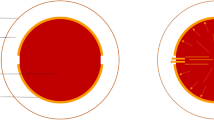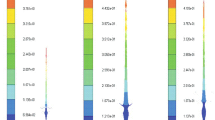Abstract
In this paper, the penetration performance of shaped charge in tandem warhead with different liner materials into thick concrete targets is investigated. For this purpose, the penetration process and the damage mechanism of concrete target by shaped charges with two different liner materials are analyzed by experimental and numerical methods. The used materials for two liners are aluminum and copper. Comparison between experimental and numerical results is in good agreement with each other. The obtained results suggest that both types of shaped charge are capable of destroying thick concrete targets, but aluminum conical liner has more significant effect in creating penetration depth, tunnel diameter rather than copper conical liner. Also, the shaped charge with aluminum conical liner develops very large spalling and scabbing area in the front and back of the concrete target. Hence a shaped charge with aluminum material liner is quite suitable for forward projectile of tandem warhead.
















Similar content being viewed by others
Abbreviations
- A :
-
Material constant in Johnson–Cook material model
- A e :
-
Specific constant in explosive material
- A h :
-
Material constant in Johnson–Holmquist material model
- a :
-
Volumetric modification coefficient
- B :
-
Material constant in Johnson–Cook material model
- B e :
-
Specific constant in explosive material
- B h :
-
Material constant in Johnson–Holmquist material model
- C :
-
Material constant in Johnson–Cook material model
- C h :
-
Material constant in Johnson–Holmquist material model
- C v :
-
Volumetric speed of sound or the intercept of the \(U_{\text{S}} - U_{\text{P}}\) curve
- D :
-
Damage parameter
- D 1, D 2 :
-
Damage constant in Johnson–Holmquist model
- d 1, d 2, d 3, d 4, d 5 :
-
Material constants in Johnson–Cook material model
- \(E\) :
-
Internal energy
- \(f_{\text{c}}\) :
-
Unconfined compressive strength of concrete
- F :
-
Fraction burn parameter
- K 1, K 2, K 3 :
-
Pressure constant in Johnson–Holmquist material model
- M :
-
Material constant in Johnson–Cook material model
- N :
-
Material constant in Johnson–Cook material model
- \(N_{\text{h}}\) :
-
Material constant in Johnson–Holmquist material model
- P :
-
Applied pressure
- \(P_{\text{eos}}\) :
-
Pressure of the equation of state
- \(P_{{}}^{*}\) :
-
Normalized pressure
- \(P_{\text{lock}}\) :
-
EOS constant (locking pressure) in JC material
- R 1, R 2,:
-
Specific constants of explosive material
- \(S_{1} , \;S_{2} ,\;S_{3}\) :
-
First, second, and third coefficients in curve slope of \(U_{\text{S}} - U_{\text{P}}\)
- \(T_{\text{ref}}\) :
-
Surrounding temperature
- \(T_{\text{melt}}\) :
-
Melting temperature
- \(T^{*}\) :
-
Dimensionless temperature
- \(U_{\text{S}}\) :
-
Wave speed
- \(U_{\text{P}}\) :
-
Particle speed
- \(\acute{V}\) :
-
Dependent volume
- \(\gamma_{0}\) :
-
Gruneisen coefficient
- \(\dot{\varepsilon }\) :
-
Actual strain rate
- \(\varepsilon_{ij}^{\prime }\) :
-
Deviatoric strain rate
- \(\dot{\varepsilon }_{0}\) :
-
Reference strain rate
- \(\dot{\varepsilon }^{*}\) :
-
Dimensionless strain rate
- \(\varepsilon_{\text{f}}\) :
-
Fracture strain
- \(\bar{\varepsilon }_{\text{p}}\) :
-
Effective plastic strain
- \(d\bar{\varepsilon }^{\text{p}}\) :
-
Change in the effective plastic strain
- \(\Delta \varepsilon_{\text{p}}\) :
-
Incremental equivalent plastic strain
- \(\mu_{\text{crush}}\) :
-
EOS constant (crushing volumetric strain)
- \(\mu_{\text{lock}}\) :
-
EOS constant (locking volumetric strain)
- \(\bar{\mu }\) :
-
Volumetric strain
- \(\mu_{\text{v}}\) :
-
Fluid’s viscosity coefficient
- \(\Delta \mu_{\text{p}}\) :
-
Incremental plastic volumetric strain
- \(\rho\) :
-
Current density
- \(\rho_{0}\) :
-
Initial density
- \(\sigma\) :
-
Actual equivalent stress,
- \(\sigma_{ij}\) :
-
Components of stress tensor
- \(\bar{\sigma }\) :
-
Effective stress
- \(\acute{\sigma_{ij}}\) :
-
Deviatoric stresses
References
Xiao QQ, Huang ZX, Zhu CS, Zu XD (2012) Calculation of depth and crater diameter for the supersonic penetration of shaped charge jet into concrete. Propell Explos Pyrot 38:224–231
Martiz MF, Mostert FJ, Terblanche CJ (2008) An analytical investigation of the energy-volume relationship observed in concrete targets penetrated by shaped charge jets. 24th International Symposium on Ballistics, New Orleans, LA, pp 838–845
Murphy MJ, Kuklov RM, Rambur TA, Switzer LL, Summers MA (2004) Single and multiple jet penetration experiments into geologic materials. 21th International Symposium on Ballistics, Adelaide, Australia, pp 40–47
Murphy MJ, Baum DW, Kuklo RM, Simonson SC (2001) Effect of multiple and delayed jet impact and penetration on concrete target borehole diameter. 19th International Symposium on Ballistics, Interlaken, Switzerland, pp 1553–1559
Pincosy PA, Murphy MJ (2007) Calculated concrete target damage by multiple rod impact and penetration. 23th International Symposium on Ballistics, Tarragona, Spain, pp 1453–1460
Wang C, Ma T, Nin J (2008) Experimental investigation of penetration performance of shaped charge into concrete target. Acta Mech Sinica 24:345–349
Resnyansky AD, Katselis G, Wildegger-Gaissmaier AE (2004) Experimental and Numerical Study of the Shaped Charge Jet Penetration against the Concrete Target. 21st International Symposium on Ballistics. Adelaide, Australia: paper 1
Xiao QQ, Huang ZX, Zu XD, Zhu CS (2013) Penetration research of jacketed jet into concrete. Int J Impact Eng 54(4):246–253
Wang J, Wang C, Jg Ning (2008) Theoretical model for calculation of concrete target resistance and numerical simulation of penetration by shaped charge jets. Acta Armamentarii 29:1409–1416
Xiao QQ, Hung Zx GuXh (2010) Engineering research on radial crater growth for the penetration in concrete target by shaped charge jet. Acta Armament 31:464–468
Holmquist TJ, Johnson GR, Cook WH (1993) A computational constitutive model for concrete subjected to large strains, high strain rates and high pressure. 14th International Symposium on Ballistics, Quebec, pp 591–600
Khazraiyan N, Liaghat GH, Khodarahmi H, Dashtian Gerami N (2013) Analysis of perforation process into concrete/metal target by rigid projectile. Proc Inst Mech Eng C J Mec 227:1454–1468
Khazraiyan N, Liaghat GH, Khodarahmi H (2013) Normal impact of hard projectile on concrete targets. Struct Concr 14:176–183
Carleone J (1993) Tactical missile warhead progress in astronautics and aeronautics, 2nd edn. AIAA, Washington
Author information
Authors and Affiliations
Corresponding author
Additional information
Technical Editor: Eduardo Alberto Fancello.
Rights and permissions
About this article
Cite this article
Gerami, N.D., Liaghat, G.H., Moghadas, G.H.R.S. et al. Analysis of liner effect on shaped charge penetration into thick concrete targets. J Braz. Soc. Mech. Sci. Eng. 39, 3189–3201 (2017). https://doi.org/10.1007/s40430-017-0797-6
Received:
Accepted:
Published:
Issue Date:
DOI: https://doi.org/10.1007/s40430-017-0797-6




